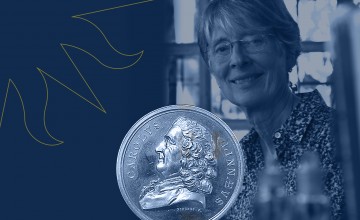
Usted está aquí
Mary Jane
West Eberhard
Las hembras en los nidos de avispas sociales tropicales compiten y cooperan en formas que dependen de su entorno social, revelando patrones de variación y selección que esclarecen los principios de la evolución
Proyectos y noticias
Enfoque de investigación
Mi trabajo de campo es sobre las avispas sociales tropicales (Vespidae). Me interesa la evolución del comportamiento social, la selección social (incluida la selección sexual), la relación entre el desarrollo influenciado por el ambiente (“plasticidad de desarrollo”) y la teoría genética de la evolución, incluyendo la evolución adaptativa de fenotipos (fisiológicos, morfológicos y de comportamiento), especiación, macroevolución, modularidad y homología.
Contacto
Reseña de investigación
¿Cómo explican la evolución los estudios comparativos de campo sobre la historia natural y el comportamiento de las avispas?
Observando el comportamiento y la historia natural de varios tipos de avispas tropicales que viven en colonias, en particular las interacciones de individuos dentro de los grupos, se puede ver lo que probablemente ha sido fundamental para su diversificación y especialización como animales sociales.
¿Cómo puede la competencia social llevar a la estratificación social y afectar la distribución de recursos?
La competencia social (selección social), ya sea para parejas (selección sexual darwiniana) o para otros recursos (por ejemplo, entre avispas hembra) lleva a la evolución de señales de rango y a la jerarquía social y la estratificación. Estoy estudiando las pruebas de que esto afectó el acceso a los alimentos durante la evolución humana, y ayudó a definir ciertos aspectos de la forma del cuerpo humano y de la epidemia de obesidad.
¿Cuáles son los efectos de la plasticidad de desarrollo en la evolución adaptativa?
Comenzando con los principios planteados en un libro (West-Eberhard 2003) sobre plasticidad de desarrollo y evolución, estoy evaluando una nueva hipótesis sobre los efectos fetales de la nutrición materna en el fenotipo adulto, en relación con la obesidad y las enfermedades crónicas asociadas (por ejemplo, diabetes tipo 2 y enfermedad cardiovascular).
Educación
B.A., University of Michigan, 1963.
Ph.D., University of Michigan, 1967.
Publicaciones destacadas
2019. Nutrition, the visceral immune system, and the evolutionary origins of pathogenic obesity. Proc. Nat. Acad. Science 116(3):723-731.
2019. Modularity as a universal emergent property of living things. J. Exp. Zoology B 2019:1-9.
West-Eberhard, M.J. 2014. Darwin's forgotten idea: the social essence of sexual selection. Neuroscience and Biobehavioral Reviews 46(2014):501-508.. doi:10.1016/j.neubiorev.2014.06.015
2011. Photosynthesis, reorganized. Science 332:311-312. (with J.Andrew C. Smith and Klaus Winter).
2009. A Brief Just-so Story of My Life (A few of the Reminiscences that are Fit to Print). In Drickamer, L.C and Dewsbury, D.A. (eds.), Leaders In Animal Behaviour; The Second Generation. Cambridge University Press, Cambridge, 58 pp.
2007. Are genes good markers of biological traits? In Biological Surveys. National Research Council Committee on Advances in Collecting and Utilizing Biological Indicators and Genetic Information in Social Science Surveys. Weinstein, M., Vaupel, J. W. and Wachter, K.W. (editors), National Academies Press, Washington. 175-193.
2007. Developmental Plasticity, Evolution and the origins of disease. In Nesse, R. (ed.), Evolution And Medicine, Henry Steward Talks, London. www.hstalks.com [recorded lecture with power point illustrations, available on CD]
2007. Dancing with DNA and flirting with the ghost of Lamarck. Biology & Philosophy 22(3):439-451.
2005. Using ethics to fight bioterrorism. Science 309:1013-1014. (with P.C. Agre, S. Altman, F.R. Curl and T.N. Wiesel).
2005. The behavior of the primitively social wasp Montezumia cortesioides Willink (Vespidae, Eumeninae) and the origins of vespid sociality. Ecology Ethology and Evolution 17:51-65.
2005. Phenotypic accommodation: Adaptive innovation due to developmental plasticity. Journal of Experimental Zoology Part B (Molecular and Developmental Evolution) 304B:610-618.
2005. Developmental plasticity and the origin of species differences. Proceedings National Academy of Sciences USA 102, Suppl. 1:6543-6549.
2005. Juvenile hormone, reproduction, and worker behavior in the neotropical social wasp Polistes canadensis. Proceedings National Academy of Sciences USA 102(9):3330-3335 (with T. Giray and M. Giovanetti).
2005. The maintenance of sex as a developmental trap due to sexual selection. Quarterly Review of Biology 80(1):47-53.
2005. Howard E. Evans 1919-2002. Biographical Memoirs, Volume 86. National Academies Press, Washington, D.C., pp. 1-19.
2003. Developmental Plasticity And Evolution. Oxford University Press, New York, xx + 794 pp.
1998. Evolution in the light of developmental and cell biology, and vice versa. Proceedings National Academy of Sciences USA 95:8417-8419. [commentary on "Evolvability"]
1996. Wasp societies as microcosms for the study of development and evolution. Natural history and evolution of paper wasps, 290-317.
1996. Natural History and Evolution of Paper Wasps. Oxford University Press, Oxford. (editor, with S. Turillazzi). xiv + 400 pp.
1992. Behavior and evolution. In Molds, Molecules, and Metazoa: Growing Points in Evolutionary Biology. Grant, P. R. and Horn, H. (eds.), Princeton University Press, pp. 57-75.
1992. Adaptation, Current Usage. In Keywords In Evolutionary Biology, Keller, E. and Lloyd, E. A. (eds.), Harvard University Press, Cambridge, Mass., pp. 13-18.
1989. Phenotypic plasticity and the origins of diversity. The Annual Review of Ecology, Evolution, and Systematics. Syst. 20:249-278.
1987. Flexible strategy and social evolution. In Animal Societies: Theories And Facts, Y. Ito, J. L. Brown, and J. Kikkawa, eds., Japan Scientific Societies Press, Ltd., Tokyo, pp. 35-51.
1986. Alternative adaptations, speciation and phylogeny. Proceedings National Academy of Sciences USA 83:1388-1392.
1983. Sexual selection, social competition, and speciation. Quarterly Review of Biology 58(2):155-183.
1979. Sexual selection, social competition, and evolution. Proc. Amer. Phil. Soc. 51(4):222-234.
1975. The evolution of social behavior by kin selection. Quarterly Review of Biology 50(1):1-33.
1970. The Wasps. University of Michigan Press, Ann Arbor, vi + 265 pp. (with H. E. Evans).
1969. The Social Biology of Polistine Wasps. Misc. Publ. Univ. Mich. Mus. Zool. 140:1-101.
1967. Foundress associations in Polistine Wasps: dominance hierarchies and the evolution of social behavior. Science 157(3796):1584-1585.

